Witness The Magnificent Luxor Temple In Luxor
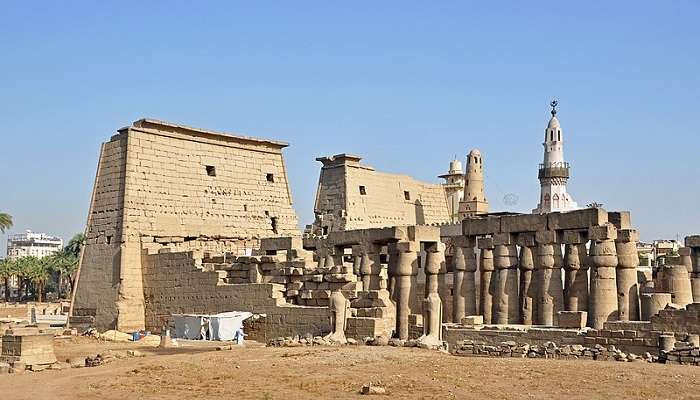
The Luxor Temple, located in Egypt, was constructed centuries ago to worship deities. Adorned with imposing pylons at its entrance, the temple features chambers and spacious areas supported by towering stone pillars. Intricate images and inscriptions adorn the stone walls throughout the temple. Situated alongside the Nile River, in Luxor this magnificent edifice was erected over generations by pharaohs the rulers of ancient Egypt. The grandeur and intricacy of Luxor Temple offer a glimpse into the power wielded by monarchs of yore, providing visitors with a captivating journey through history.
About Luxor Temple

The Luxor Temple, located on the east bank of the Nile in Luxor (ancient Thebes), goes way back to about 1400 BCE. It’s called “Pet Rest” in Egyptian, which means “the southern sanctuary.”It’s one of the primary temples on the east bank, alongside Karnak. Not at all like different sanctuaries in Thebes, Luxor Sanctuary isn’t devoted to a particular god or pharaoh. All things being equal, everything no doubt revolves around resuscitating authority.
Numerous pharaohs, including Alexander the Incomparable, are said to have been delegated there. The temple complex boasts chapels constructed by Amenhotep III of the 18th Dynasty and additions by Alexander, Tutankhamun, and Ramesses II.
In the Roman era, the temple and its environs served as a legionary fortress and the administrative centre for the Roman government in the region. A chapel initially devoted to the goddess Mut was repurposed as a Tetrarchy cult chapel during the Roman period, later becoming a church. Luxor Temple, along with other archaeological sites in Thebes, was designated a UNESCO World Heritage Site in 1979. It stands as a testament to ancient Egyptian architectural and religious significance.
Must Read: Shopping In Luxor
History Of Luxor Temple
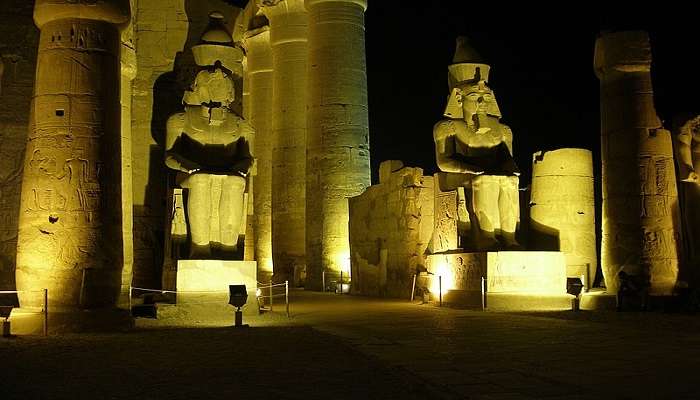
The illustrious city of Thebes, known as Waset in ancient Egypt, stood proudly in what is now Luxor. As Egypt’s capital from the twelfth dynasty (1991 BC), it flourished particularly during the New Kingdom era. Originally constructed by Amenhotep III and later enhanced by Tutankhamun (1336-27 BC) and Horemheb (1323-1295 BC), the temple in Luxor saw further expansion under Rameses II (1279-13 BC). Notably, a granite monument honouring Alexander the Great was added in the rear area (332-305 BC).
The Luxor Temple has a fascinating history. It started as a sacred site; over time, different religious groups adapted it for their practices. During the Christian era, the temple’s hypostyle hall became a church. Later, a mosque was built on top of the temple, and when the temple was uncovered, the mosque was preserved and incorporated into the complex.
The entrance to the temple was originally at the northern end of the Court, featuring impressive papyrus-style columns. Visitors would pass through the Court to reach the Hypostyle Hall, which has thirty-two imposing columns. Beyond that lie chambers with historical significance, including the birth room and a chapel dedicated to Alexander the Great. Today, Luxor Temple is one of Egypt’s best-preserved ancient structures. It was commissioned by Pharaoh Amenhotep III around 1400 BCE to honour the gods Amun, Mut, and Khonsu. Tourists are captivated by its architectural beauty and rich heritage. Located on the eastern bank of the Nile River in Luxor, it is a place of worship.
Facts About Luxor Temple

Some of the popular facts about Luxor Temple:
- Luxor Temple was a very important place in ancient Egypt, where pharaohs were crowned and some rulers were buried.
- Originally, it was connected to Karnak Temple by a road called the Avenue of Sphinxes, showing how these religious sites were linked.
- One of its original obelisks is missing, which adds a sense of mystery to the temple.
- Alexander the Great respected the temple’s importance and built a shrine there, adding to Egypt’s rich history.
- Luxor Temple also hosted the annual Opet Festival, which attracted many pilgrims and highlighted its role as a centre of religious and ceremonial activities in ancient Egypt.
Suggested Read: Luxor Travel Tips
Architecture And Design
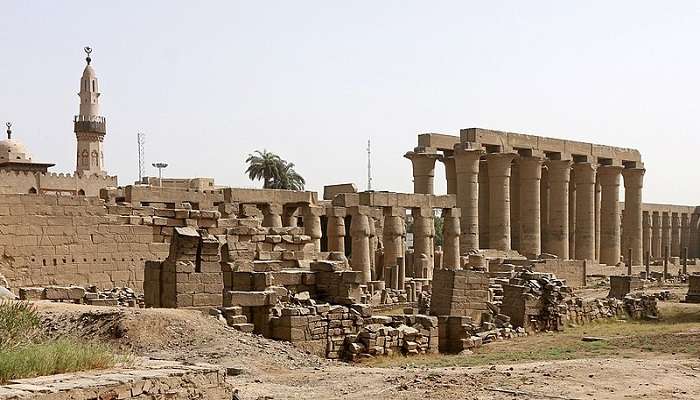
Luxor temple architecture stands out for its grandeur, featuring massive columns adorned with hieroglyphics narrating tales of ancient Egyptian life alongside statues portraying deities such as Amun-Ra and Isis. The Luxor temple construction was meticulously constructed using Nubian sandstone sourced from the Gebel el-Silsila area in South-Western Egypt.
Its architecture employed symbolism and illusionism. For instance, the two obelisks flanking the entrance appear to be of equal height, creating a visual illusion. Notable pharaohs such as Amenhotep III of the 18th Dynasty, Tutankhamun, and Ramesses II contributed to different parts of the temple’s construction.
Entrance Fees and Opening Hours
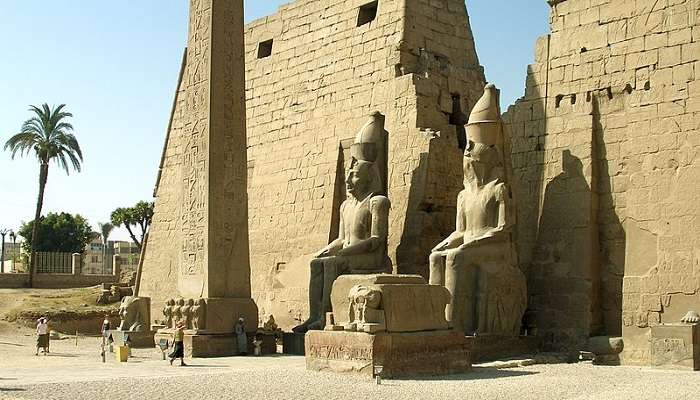
Visitors can enter Luxor Temple for 40 EGP per person to explore the wonders. This grants access to all areas encompassing monuments such as obelisks and sphinxes, as well as walls adorned with hieroglyphs depicting tales of ancient Egyptian existence.
The temple welcomes guests daily from 6:00 AM to 9:00 PM.
Suggested Read: Day Trips From Luxor
What Is The Best Time To Visit Luxor Temple?

The best time to visit Luxor is from October to April when the weather is mild, ranging from 20°C to 30°C, making it perfect for exploring. During these months, there’s plenty of daylight to enjoy famous spots like Karnak Temple, Valley of the Kings, and Luxor Temple. But remember, this is also the busiest time, so expect bigger crowds and higher prices at attractions.
How To Reach Luxor Temple From Luxor?
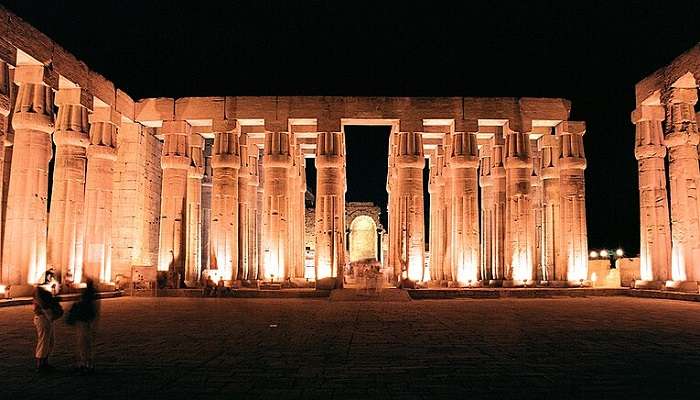
To reach Luxor Temple from the city centre of Luxor, you have a few options:
By Air
Luxor International Airport (LXR) lies approximately 3.7 miles from Luxor’s city centre. Expect a taxi fare of around E£50 for the trip to downtown Luxor.
By Train
Consider taking a train between Cairo’s Ramses Station and Luxor for an economical journey. One-way tickets typically cost E£100 to E£150.
By Driving
75M links Sharm El Sheikh in Sinai to Luxor and other major cities on the Egyptian mainland, offering a convenient option for those travelling by car.
By Bus Service
Buses from Sinai conclude their journey at Luxor Temple, covering the distance in about 6.5 hours at a standard fare of E£140.
Further Read: Things To Do In Luxor
Luxor Temple is a testament to ancient Egyptian civilisation’s grandeur and architectural prowess. Its towering columns, intricate reliefs, and awe-inspiring scale transport visitors back in time, offering a glimpse into the rich cultural heritage of this fascinating land. If you’re captivated by Luxor Temple’s allure and ancient Egypt’s mysteries, plan your trip to Egypt and make it unforgettable.
For our editorial codes of conduct and copyright disclaimer, please click here.
Cover Image Credit: Marc Ryckaert for Wikimedia Commons
Frequently Asked Questions About Luxor Temple
What is unique about the Luxor Temple?
The Luxor Temple, established around 1400 BCE, is situated on the east bank of the Nile River in Luxor (ancient Thebes). Unlike many other temples, it is not dedicated to a particular cult god or pharaoh but symbolizes the rejuvenation of kingship. It is believed to have been a site for coronation ceremonies for numerous pharaohs.
Why is Luxor so famous?
Luxor Temple is renowned for its historical significance and the annual Opet Festival. It served as a central location for religious ceremonies and rituals in ancient times.
Which god was the Luxor Temple dedicated to?
The Luxor Temple is dedicated to three deities: Amun, Mut, and Khonsu.
How old is Luxor Temple?
The Luxor Temple dates back to approximately 1400 BCE.
Who was buried in the Luxor Temple?
Upon his death in 1244, Abu’l-Hajjaj, who had garnered a devoted following in Luxor, was over 90 years old. His remains found their resting place in a mausoleum situated atop the ancient church, now partially buried below ground level.
People Also Read:
Mangaladevi Temple Pura Taman Kemuda Saraswati Chamundeshwari Temple

Experience the world through captivating stories of adventure and travel. As a senior content writer, I bring my passion for exploration to life, crafting tales that take you on a journey. With my words, you’ll feel the thrill of discovery and the joy of experiencing new cultures. Let me turn your imagination into a reality with stories that inspire you to explore and embrace the world.











